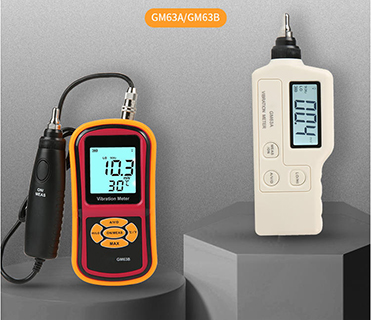What is Vibration Meter?
Vibration meter is an instrument used to measure the peak value, peak-to-peak value, average value or root mean square value of vibration such as velocity, acceleration and displacement. The vibration meter can be applied in mechanical manufacturing, electric metallurgy, general aviation etc. The main parts of this instrument are integral differential circuit, amplifying circuit, voltage detector and meter head. The integral differential circuit is used to complete the integral differential operation between the above vibration quantities. Generally, integral and differential operational amplifiers can be used, low-pass filters and high pass filters can also be used to complete integral differential operations. However, we should pay attention to this instrument's application frequency range when we are using it for calculation. The vibration meter can only obtain the total intensity (vibration level) of the vibration, but cannot obtain other information, so its scope of using is limited.
- Principle of vibration:
For the measurement method of vibration, it is required that it cannot be influenced during the measurement. Therefore, it is ideal to measure vibration by a non-contact method if a point away from the measured object can be used as a stationary reference point. However, when the vibration of a moving vehicle is measured, there are many cases where the stationary point is not available as a reference. In this situation, the inertial vibration meter is often installed on the measuring object to indirectly measure the vibration of the measured object from the movement of the vibrator.
- Vibration parameters:
- Amplitude: Represents the magnitude of vibration, the "severity" of damage to equipment or mechanical components. When calculating the amplitude, it needs to be expressed as the root mean square value (rms).
- Units of amplitude: displacement value (mm), velocity value (mm/sec), acceleration value (g).
- Frequency: Represents the source of vibration, the "cause"of damage to equipment or mechanical components.

- Frequency units: occurrences per second (Hz or CPS), occurrences per minute (CPM).
- Phase: Represents the interrelationship of vibration between measuring points, the "operational mode" of equipment or mechanical components.
- The unit of phase: degree (°)
- Energy: The "impact condition" that represents the destructive force of vibration, equipment or mechanical component damage.
- Common vibration meters:
- Handheld vibration meter:
Handheld vibration and fix the weight (about 1.5-2 grams) with the handle on the back shell of the dial indicator. Its characteristic is that the structure is simple, it can measure vibration in any direction, and the measurement speed is 1000-2000 rpm with little error. - Table frame vibration meter:
The table frame vibration meter will be fixed in the dial indicator frame, the table frame is fixed in the bracket isolated from the ventilator, and make the micrometer measuring rod and bearing box surface or other measuring parts contact. This kind of vibration meter with simple structure and it does not need to make any other machine parts, and it can measure the vibration of any direction. The disadvantage of the table frame vibration meter is that the bracket is not easy to isolate from the vibration, the accuracy is poor. - Piezoelectric vibration meter:
Piezoelectric vibration meter is characterized by high natural frequency, wide frequency range, small volume, light weight and small influence on the measured object, so it is widely used in measuring vibration acceleration. The internal resistance of piezoelectric vibration sensor is high, and the cable connected with amplifier is easy to introduce interference. Therefore, it is hoped that the cable should be as short as possible and shielding should be considered, and the preamplifier should be placed near the sensor as much as possible. Most amplifiers used to amplify the electrical signals generated by piezoelectric sensors are mostly charge amplifiers now. - Portable vibration meter:
The portable vibration meter is small in size, light in weight, and compact in structure. The instrument integrates multi-channel vibration collection, infrared temperature measurement, laser speed measurement, manual copying, electronic tags and other functions. It not only meets the requirements of portable collection, but also realizes a powerful field Data acquisition and machine failure analysis functions, in addition to recording and storage of the arrival time of the inspection personnel, optional path recognition system, automatic identification of the number of the tested machines, convenient for spot inspection and positioning; support networked data management and analysis and diagnosis functions. - Mechanical vibration meter:
It consists of a inserting spring K (or several springs) inside the housing and installing a mass block of mass m under the spring. This also makes up the mechanical resonant system. Usually mechanical resonant systems are containing damping. The actual vibration sensor, using the housing as a base, is fixed on top of the object to be measured and detects the relative motion between the mass block m and the housing, mechanically, optically, or electrically.
- Precautions for using the vibration meter:
- The instrument should avoid strong impact, high temperature and immersion.
- Take out the battery of the instrument when it is not be used for a long time.
- Battery installation
(1) Open the battery compartment cover which behind the instrument lower cover and take out the battery.
(2) Put the four button batteries into the battery compartment according to the correct polarity (the positive pole of the battery is upward), and restore the battery compartment cover.
(3) When the sensor is used for more than one year, please recalibrate the vibration meter to ensure its measurement accuracy.
(4) Test conditions: room temperature: 20 ℃± 5 ℃; relative humidity < 80%

